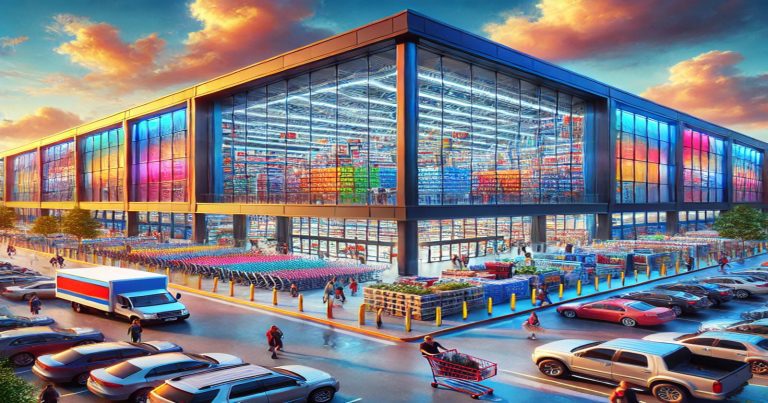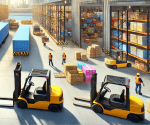Today, the strategy for shopping and retail has made a maritime change, with increasing demands worldwide. Strong, populated consumers prefer their needs within the comfort of a large-to-life scenario for shopping instead of getting out of comfort around the local mother-pap-type store for personal consumption. Most such giant-size retail sales are Big-Box or Hyper Store, Super-Sentor and Super-Store/Megastores. Although each of these words has its peculiar features, they all share one thing: they are one-stop shopping experiences with a wide range of products, from grocery accessories to electronics.
In this article, we will discuss the concept of large shops, differences and equality, the differences and similarities between a large-box store, hyperstore, superstore, superstore and megastar, and why they are so popular in the modern retail landscape.
What are Big Shops?
Larger shops are large retail shops designed to provide a wide range of products and services in a vast place. They plan to facilitate efficiency, convenience and diversity by attracting thousands of customers daily. Such shops are usually located in suburban areas with adequate parking space, making it possible for many shopkeepers to access them. Although the use of Big-Box Stores, Hypertor, Superstore and Megastor is interconnected, the difference is a specialty of differences regarding their formats and offerings. Here is a quick manner of each word:
- Big-Box Store: Big, warehouse-style retail stores that are part of a national or international chain. They have very large floors and usually have wall-marts and home depots.
- Hypstore: It is a mixture of a supermarket and a departmental STO
- Supercenter: Similar to a hyperstor, but often with standard goods, it focuses more on everyday essential things. Walmart Supercenter is a prime example.
- Superstore: A large retail store that sells a wide range of products, usually specializing in a particular category, such as electronics, household goods or clothes. Buy the best and targets are examples.
- Megastore: A huge retail location, more significant than a superstore, offers many products and services, often including entertainment options. Ikea can be considered a megastar due to its vast product range and large showrooms.
Key Features of Big Shop
While names may vary, these big shops share several significant features that characterize them and make them attractive to be shopped by consumers.
Large Retail Space
The most typical and defining feature of a big-box store, hyperstore, supercenter, superstore, or megastore is the tremendous size that reaches tens of thousands of square feet. Therefore, it accommodates a broader product range within its stores, so retailers create categories like grocery items, clothes, electronics, housewares, or even furniture products in sections and subsections as per demand and availability.
A supercenter such as Walmart may accommodate up to over 180,000 square feet. Here, a wide range of produce is found up to auto supplies. A megastore can be more than 300,000 square feet, encompassing enormous showrooms, restaurants, and even places to play with children.
One-stop Shopping Experience
One of the most significant advantages of shopping at a big-box store, hyperstore, supercenter, superstore, or megastore is the convenience of getting everything you need in one place. You can find groceries, electronics, clothing, and household goods at these stores.
This one-stop shopping experience saves time and effort for busy families or individuals with tight schedules. Customers do not have to visit multiple small shops to find their essentials; all can be found under one roof.
Competitive Pricing
Because big-box stores, hyperstores, supercenters, superstores, and megastores are big in scale and sell a large volume of items, they can sell products at competitive prices. They purchase from suppliers in huge quantities, enabling them to make better deals, which they pass on to their customers.
This is why you’ll often find lower prices on everyday items at stores like Costco (a popular big-box store) or Carrefour (a leading hyperstore). These cost advantages make big shops a preferred choice for budget-conscious shoppers.
Wide Product Variety
Unlike traditional retail stores, big shops offer various products, which may specialize in a particular category. A hyperstore or supercenter might stock everything from fresh food to electronics, toys, and garden equipment.
With offerings ranging from mere furniture to items like home décor, appliances for the kitchen, and edible products, there is a product for every section of the family. Such inventory diversification attracts all kinds of shoppers, making these stores another destination for multiple shopping.
Strategic Locations with Ample Car Parking
Most big-box stores, hyperstores, supercenters, superstores, and megastores are found on the outskirts of cities or in suburban areas where land is cheaper. This way, it allows stores to have large sizes, substantial parking areas, and significant stores where drive-through customers can easily find their preferred stores.
Examples are supercenters like Walmart, which most of the time is located right next to highways, and megastores like IKEA, with ample parking areas to accommodate hundreds of their customers’ vehicles.
Advantages of Shopping at Big-Box Stores
Big, warehouse-style retail stores that are part of a national or international chain. They have very large floors and usually have wall-marts and home depots. The advantages of Shopping at big box stores are:-
Convenience
The benefits shoppers get when shopping at a big-box store, hyperstore, supercenter, superstore, or megastore are the convenience of buying groceries, electronics, clothing, and household items all at one stop, saving time and trouble.
Cost Savings
Thanks to volume buys and streamlined distribution channels, these stores are more competitive in pricing than local retailers. Even superstores like Costco add more savings for their members through their membership plans and purchase discounts by volume.
Consistent Inventory
Due to their extensive distribution centers and stockrooms, big-box stores rarely experience stockouts of frequently purchased items. A supercenter like Walmart ensures that essential items are always available, especially in busy seasons.
Add-on Services
Many hyperstores and supercenters provide additional service offerings, including pharmacies, optical centers, banking services, and even food and beverage outlets like fast-food restaurants. It gives much value beyond retail space.
Loyalty Programs and Membership Benefits
Stores like Costco (a big-box store) and Sam’s Club offer membership programs that provide exclusive discounts, cashback, and early access to sales. Superstores like Target also have loyalty programs that reward frequent shoppers.
Disadvantages of Big-Box Stores
These large retail formats do have many advantages but also some disadvantages.
Threat to Small Businesses
The existence of big-box stores, hyperstores, supercenters, superstores, and megastores is a challenge to small, local businesses. They cannot compete with them because they cannot sell merchandise at lower prices and provide customers with a more extensive variety of products.
High Operating Costs
A megastore or supercenter requires significant utilities, amongst other things, to function. This expense is one of the sensitive expenses in an economic downturn, as the expenditure levels are likely to be lower.
Environmental Impact
In addition to the massive physical presence, these enormous structures have vast parking lots. Mega-superstores raise issues like urban sprawl, vehicular traffic, and higher energy usage.
Labor Force Problem
While these stores generate employment, the products offered are criticized for the employees’ wages, working conditions, and limited growth opportunities. Most superstores and hyperstores cannot balance cost efficiency with fair labor practices.
Dependence on Foot Traffic
While many big-box stores and supercenters now offer online shopping options, they still heavily depend on in-store traffic. Such events as the COVID-19 pandemic only brought to light more of the vulnerabilities of this model and forced many retailers to adapt to digital trends quickly.
Popular Examples of Big Shop
Here are a few globally recognized brands that fall into these categories:
- Big-Box Store: Walmart, Costco, Home Depot
- Hyperstore: Carrefour, Tesco Extra, Auchan
- Supercenter: Walmart Supercenter, Meijer, Fred Meyer
- Superstore: Target, Best Buy, Staples
- Megastore: IKEA, Toys “R” Us in its heyday, Decathlon
Each store has its place in the retail firmament, offering an amalgamation of affordability, convenience, and product mix.
The Future of Big Shops
Big-box stores, hyperstores, supercenters, superstores, and megastores continue to evolve in the retailing industry. They can invest in online shopping platforms or even introduce click-and-collect services. Technologies will further improve the experience they give their customers.
In this context, Walmart is focusing on its e-commerce platform to catch up with Amazon. In the case of IKEA, the megastore format continues to usher in even smaller stores in urban cities but sticks to the more prominent flagships. Hyperstores like Carrefour use digital elements to improve inventory management and personalized marketing.
Despite the boom in online shopping, big shops retain their allure. Their ability to offer tangible shopping experiences, immediate product access, and additional in-store services ensures they will continue to play a leading role in the global retail industry.
Big Shop FAQs
What is a big-box store?
A big-box store is a large, warehouse-style retail outlet offering various products, often at discounted prices.
How does a hyperstore differ from a supercenter?
A hyperstore combines a supermarket with a department store, whereas a supercenter focuses more on everyday essentials and general merchandise.
What is an example of a megastore?
IKEA is a classic example of a megastore because it offers many products and has a large showroom area.
Why do shoppers like superstores?
Superstores are favored because they offer convenience, low prices, and a wide variety of products in one place.
Do big-box stores sell on the internet?
Many big-box retailers, such as Walmart and Target, sell online and offer home delivery or in-store pickup.


